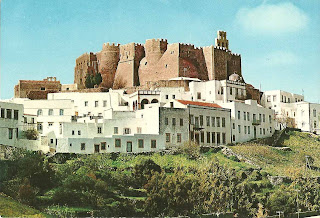This postcard was also found in that abandoned house. It shows Patmos island, but it is not used, so it doesn't have a date on it. I have never been to Patmos, but I have been told that it is one of the most beautiful Greek islands!
Patmos (Greek, Πάτμος; Italian: Patmo) is a small Greek island in the Aegean Sea. One of the northernmost islands of the Dodecanese complex, it has a population of 2,984 and an area of 34.05 km² (13 square miles). The highest point is Profitis Ilias, 269 meters above sea level. The Municipality of Patmos, which includes the offshore islands of Arkoi (pop. 54), Marathi (pop. 6), and several uninhabited islets, has a total population of 3,044 (2001 census) and a combined land area of 45.039 km². It is part of the Kalymnos peripheral unit.
Patmos' main communities are Chora (the capital city), and Skala, the only commercial port. Other settlements are Grikou and Kampos. The churches and communities on Patmos are of the Eastern Orthodox tradition. In 1999, the island's historic center Chora, along with the Monastery of Saint John the Theologian and the Cave of the Apocalypse, were declared World Heritage Sites by UNESCO. The monastery was founded by Saint Christodulos. Patmos is also home to the Patmian School, a notable Greek seminary.
Patmos is mentioned in the Christian scriptural Book of Revelation. The book's introduction states that its author, John, was on Patmos when he was given (and recorded) a vision from Jesus. Early Christian tradition identified this writer John of Patmos as John the Apostle, though some modern scholars are uncertain. As such, Patmos is a destination for Christian pilgrimage. Visitors can see the cave where John is said to have received his Revelation (the Cave of the Apocalypse), and several monasteries on the island are dedicated to Saint John.
According to a legend within the Greek mythology, the island's original name was "Letois," after the goddess Artemis, daughter of Leto. It was believed that Patmos came into existence thanks to her divine intervention. Mythology tells of how Patmos existed as an island at the bottom of the sea.
Deer-huntress Artemis frequently paid visits to Caria, the mainland across the shore from Patmos, where she had a shrine on Mount Latmos. There, she used to meet up with the moon goddess Selene, who cast her light on the ocean, revealing the sunken island of Patmos.
Selene was always trying to get Artemis to bring the sunken island to the surface and, hence, to life. Selene finally convinced Artemis, who, in turn, elicited her brother Apollo's help, in order to persuade Zeus to allow the island to arise from the sea.
Zeus agreed, and the island emerged from the water. The Sun dried up the land and brought life to it. Gradually, inhabitants from the surrounding areas, including Mount Latmos, settled on the island and named it "Letois" in honour of Artemis. [wikipedia]

No comments:
Post a Comment